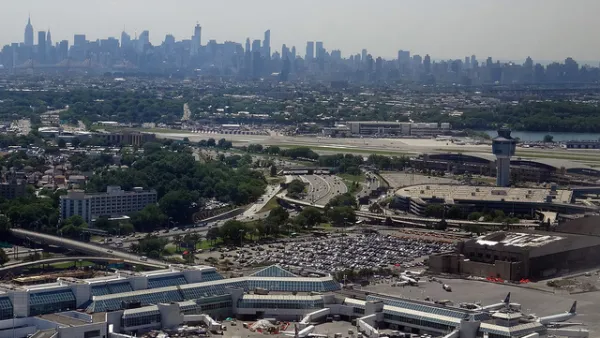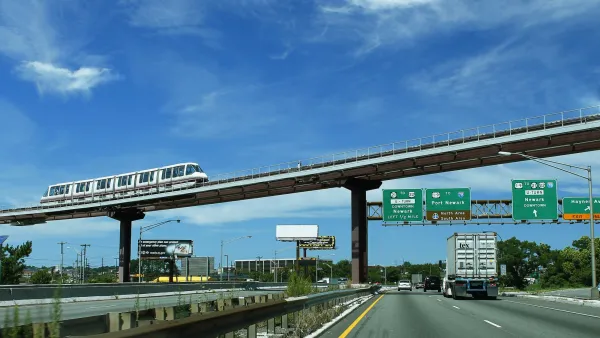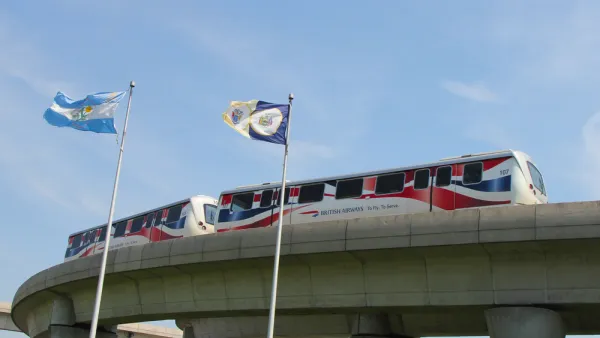LaGuardia lacks an AirTrain, unlike the two other airports that serve the New York City area, so public transit access is available via Queens and Manhattan buses. But would a $450 million proposal by New York Gov. Andrew Cuomo remedy the problem?
"As proposed, the project would do next to nothing to improve access to the airport," writes Yonah Freemark of The Transport Politic. "In fact, compared to existing transit services, most riders using the AirTrain would spend more time traveling to LaGuardia than they do now."
Freemark's time findings are charted here, showing current transit access to the airport, and access via both subway and Long Island Rail Road (LIRR) to the proposed AirTrain terminal at "the 7 Subway station at Mets-Willets Point and about 600 feet north of the LIRR station" in Queens.
This finding suggests that for most people in the Bronx, Manhattan, Queens, Brooklyn, and Long Island, AirTrain services will not be beneficial from a time perspective.
Freemark spots an likely illustration error that anyone who has ever taken an AirTrain would notice. The second slide in the "Building a New New York" [PDF] accompaniment to the governor's "2015 Opportunity Agenda: Restoring Economic Opportunity" (that describes not only the LaGuardia AirTrain but other proposals in the governor’s infrastructure plan) depicts an image of the AirTrains.
The bizarre rendering included in the governor’s presentation suggests that the project would feature an elevated guideway and train cars that appear to have been lifted from the LIRR. One can only assume that this image was photoshopped by someone who is not familiar with transportation technology.
Nevertheless, the plan clearly has its virtues. Like the AirTrain connection for JFK Airport at Jamaica, the Willets Point AirTrain terminal allows for both commuter train and subway access, although LIRR service would clearly not be as frequent as that at Jamaica Station, the hub for the LIRR and second busiest after Penn Station as all but one of its eight branches (per Wikipedia) serve it.
The one that doesn't stop there, the Port Washington branch, currently only stops at Mets-Willets Point "during Mets Home Games and special events."
Other criticisms of the proposal were included in The New York Times article (posted here).
"Andrew Albert, a rider representative on the [Metropolitan Transportation Authority] board, said he was concerned about an influx of airport-bound riders on the crowded 7 line," reports Michael M. Brynbaum.
However, as with most big-ticket transportation projects, finding the money may be the critical factor. When asked, Cuomo "said the costs would be absorbed within 'existing' state resources."
But the transportation authority, which operates and maintains bridges, buses and the New York City subway system, already has a $15.2 billion gap in its long-term capital plan, and Mr. Cuomo offered no hints of how the state might make up the difference.
“It is alarming that he would spring a new project on people without explaining how to pay for the old projects,” said Nicole Gelinas, a senior fellow at the Manhattan Institute. “Are we going to keep up with the Second Avenue subway, never mind a new project?”
However, the compelling reason for the AirTrain proposal may would be self-evident for anyone who has ever flown into or out of LaGuardia.
A survey by the Port Authority in 2008 showed that 75 percent of travelers from Manhattan used a taxi or car service to reach the airport; only 16 percent rode buses or shared a van.
FULL STORY: For LaGuardia, an AirTrain that will save almost no one any time

National Parks Layoffs Will Cause Communities to Lose Billions
Thousands of essential park workers were laid off this week, just before the busy spring break season.

Retro-silient?: America’s First “Eco-burb,” The Woodlands Turns 50
A master-planned community north of Houston offers lessons on green infrastructure and resilient design, but falls short of its founder’s lofty affordability and walkability goals.

Delivering for America Plan Will Downgrade Mail Service in at Least 49.5 Percent of Zip Codes
Republican and Democrat lawmakers criticize the plan for its disproportionate negative impact on rural communities.

Test News Post 1
This is a summary

Test News Headline 46
Test for the image on the front page.

Balancing Bombs and Butterflies: How the National Guard Protects a Rare Species
The National Guard at Fort Indiantown Gap uses GIS technology and land management strategies to balance military training with conservation efforts, ensuring the survival of the rare eastern regal fritillary butterfly.
Urban Design for Planners 1: Software Tools
This six-course series explores essential urban design concepts using open source software and equips planners with the tools they need to participate fully in the urban design process.
Planning for Universal Design
Learn the tools for implementing Universal Design in planning regulations.
EMC Planning Group, Inc.
Planetizen
Planetizen
Mpact (formerly Rail~Volution)
Great Falls Development Authority, Inc.
HUDs Office of Policy Development and Research
NYU Wagner Graduate School of Public Service





























